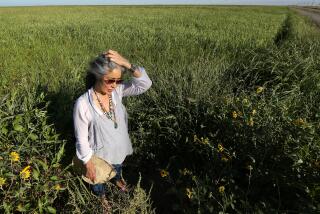Profit Blossoms on Only 75 Acres : Quality, Speed to Market Spell Success for Farmer
- Share via
EASTON, Calif. — Big isn’t beautiful when it comes to farming, says Ken Lucero, whose family agricultural operation in the San Joaquin Valley totals 75 acres.
High-intensity growing, double-cropping and early planting to capture high prices at the start of the market are keys to small-scale farming success, Lucero contends.
“I kind of see myself like the European wine-grape grower,” Lucero said as he watched a fumigator spread an acre of plastic sheets across bare land. It’s a process he repeats every other year to assure disease-free crops.
Sold in Advance
“The European guys have only a few acres, but because of the quality of what they’re growing, and the reputation for quality they’ve built up, they have it sold four years in advance. That’s my goal.”
Lucero’s family grows raisin grapes on 55 acres. He helps farm that land, but since 1979, he has concentrated on making his profit on an adjacent 20 acres.
“I can’t possibly see myself with 200 acres just to get a $30,000 net profit,” Lucero said. “If I can do that with 20 acres, all the better, because you’ve got better control of labor and all other costs.”
Like most diversified farmers, Lucero started out small--with just one acre of eggplant. He now grows everything from red Italian onions, Serrano peppers, eggplant, cherry tomatoes, zucchini squash, string beans, leaf lettuce, cilantro, daikon radish, baby bok choy and Napa cabbage.
Lucero’s rules for small-scale farming are to take care of the land and do everything possible to beat the competition to market.
Among other things, he uses clear- and black-plastic mulches and tunnels to raise soil temperatures and keep moisture in to assure an early spring crop, which allows him to plant another crop for harvest in the summer. He also fumigates every other year and spreads up to 15 tons of steer manure on each acre.
He often plants a cover crop of beans alongside vegetables rows, selling them if he can but otherwise plowing them under for soil enrichment.
Lucero also stakes and ties up many vegetables that other farmers routinely allow to spread out across the ground. It is an expensive practice, but he contends that it dramatically reduces the culling of vegetables damaged by water on the ground.
Expense Recovered
Other eggplant growers average 30% culls from their crop. Lucero says he averages 10%.
At a cost of about $700 for 1,000 stakes for an acre, Lucero was able to cover the expense with his first crop. The metal stakes last up to 10 years.
As a result of the high-intensity growing methods, Lucero says he got 2,800 boxes of eggplants per acre, compared to an average of 2,000 for other farmers in this area south of Fresno. And by getting to market several weeks before the competition last year, he also got $8 to $13 per box, instead of $2 to $5.
Lucero, who is 26, admits his type of farming isn’t for everyone.
“It’s for the guy who stresses quality. And once you deliver a good quality product early to the market, you don’t have to worry about the rest of your crop. You don’t have to call the buyers. They’ll be calling you.”
The greatest danger for the small-scale farmer is overproduction, Lucero says. And he believes a farmer should never deliver all he has to a buyer.
“Give them a little less than what they want or think you have. Once they know you have a surplus, down comes the price.”






